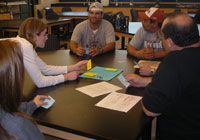

ABSTRACTThis lesson is designed to introduce students to the concepts of succession and plant community dynamics. It teaches that plant communities are dynamic, that is, they change over time and space, and that these changes result from interactions between plants, their biotic and abiotic environments, and chance events. Students play a board game in which each student represents an imaginary plant species. Each time the game is played, the students are conducting a type of theoretical experiment or simulation. Students explore plant community dynamics by playing the game and interacting with each other (as different plant species) and responding to chance events. At the end of the game, students report on the results and discuss with the class what they have learned. To apply their new knowledge, students predict changes in the community and attempt to make the community change in specific ways. We decided to teach this topic using a game for several reasons. Games are fun and students easily learn complicated sets of rules in order to play a game. Also, games are dynamic and so are an effective way to teach a dynamic subject. Third, it can take many years to observe succession in nature; the game condenses this time and allows students to watch plant community dynamics within a class period. Fourth, current curriculum about succession is limited in its applicability because it is designed to take advantage of regional examples such as old-field succession in temperate hardwood forests. Because it uses imaginary species, this game can be played anywhere in the world. AUTHORSElena Ortiz-Barney1*, Juliet C. Stromberg2, and Vanessa B. Beauchamp3 1 - Arizona State University, School of Life Sciences, P.O. Box 874601, Tempe, AZ 85287-4601, elena.ortiz@pcmail.maricopa.edu 2 – Arizona State University, School of Life Sciences, P.O. Box 874601, Tempe, AZ 85287-4601, jstrom@asu.edu 3 – Arizona State University, School of Life Sciences, P.O. Box 874601, Tempe, AZ 85287-4601 * corresponding author ___________________________________________ CLASS TIMEThis lesson can take place over the course of one two-hour period, not including extension activities. OUTSIDE OF CLASS TIMEOne to two hours for students to write reports; extension activities require more time. STUDENT PRODUCTSCompleted worksheets and a report on the results of management “experiments.” In the extension activities, students write an opinion statement based on evidence from management experiments and/or create a local version of the game using local plants instead of imaginary plants. SETTINGThis is an indoor lab. COURSE CONTEXTUsed for undergraduate non-majors in Biology and Environmental Biology courses. We have also used this activity with high school biology, middle school science students, and in-service teachers. INSTITUTIONfour-year public university and community college TRANSFERABILITYThe basic activity can be used with non-majors biology students and pre-college students. Extension activities add to the difficulty level and are appropriate for students who are ecology majors. ACKNOWLEDGMENTSThis activity was created with funding from National Science Foundation GK-12 Program and Arizona State University’s Down to Earth Science Program. We’d also like to thank Dr. Seuss and Lewis Carroll for inspiring the imaginary plant names. Special thanks to Bruce Grant and the anonymous reviewer for their editorial and pedagogical suggestions. CITATIONElena Ortiz-Barney, Juliet C. Stromberg, and Vanessa B. Beauchamp. April 2005, posting date. The Floristic Relay Game: A Board Game to Teach Plant Community Succession and Disturbance Dynamics. Teaching Issues and Experiments in Ecology, Vol. 3: Experiment #4 [online]. http://tiee.ecoed.net/vol/v3/experiments/floristic/abstract.html |

|
<top> | |